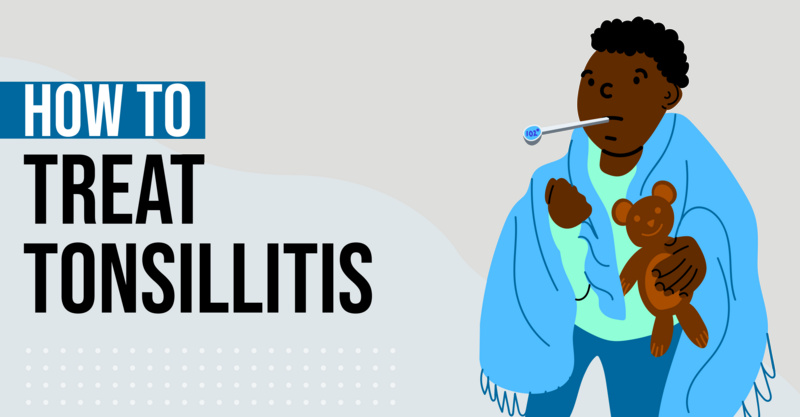Key Points
- Strep throat, or streptococcal pharyngitis, is a bacterial throat infection that can initially present like a common cold or sore throat. However, if a sore throat persists for more than two days, it could be a sign of strep.
- Symptoms of strep throat include throat pain and swelling, white or yellow patches in the throat, swollen lymph nodes, fever, and chills. While some of these symptoms can occur with other infections, the presence of white or yellow patches and fever are the best indicators of strep throat.
- Strep throat is highly contagious and primarily affects children, teenagers, and young adults. It can be spread through personal contact with nasal fluids or saliva of an infected person, or by touching objects that an infected person has touched.
- If strep throat is suspected, it's important to see a doctor immediately. A rapid strep test or throat culture can confirm the diagnosis. Treatment typically involves antibiotics and over-the-counter pain relievers.
- A viral sore throat, on the other hand, usually resolves within two days. It cannot be treated with antibiotics, but symptoms can be managed with over-the-counter medications, fluids, and rest. If a sore throat persists for two weeks or more, it's important to seek medical attention.
We all know the feeling of a sore throat coming on—the slight pressure when you take a drink, the faint swelling in your throat that you just know is going to develop into something more. Nobody likes having a sore throat, but it can be even worse when it's a sign of strep. At first, strep throat may seem similar to a sore throat caused by allergies or the common cold, but treatment and recovery times for the two illnesses are very different.
Unfortunately, you often cannot tell the difference between a sore throat and strep until your symptoms get worse. While talking to a physician is the most reliable way to know for sure whether your sore throat is a sign of strep, below you’ll learn the top strep symptoms to look out for, with helpful tips to feel better faster, no matter what’s causing your sore throat.
What is strep throat and why is it different from other causes of a sore throat?
When you first start to show signs of a sore throat, it can be hard to tell whether it’s from a cold or a strep infection. However, a sore throat from a cold should start feeling better fairly quickly. If you’ve had a sore throat for more than two days, there’s a chance that it could be strep.
Strep throat, also called streptococcal pharyngitis, is a bacterial throat infection, whereas other types of sore throats are typically caused by viral infections. Bacterial infections are not as common as viral infections, and the symptoms that you experience will be slightly different than those associated with a viral infection, such as the common cold.
Strep throat can cause a wide range of symptoms, the most notable being throat pain and swelling that may make it difficult to eat, drink, and swallow. Other symptoms of strep include:
- White or yellow streaks or patches in the back of the throat or on the tonsils
- Tenderness and swelling in the lymph nodes on the side of the neck and jaw
- Redness and swelling in the tonsils
- Headaches
- Fever and chills
- Nausea and vomiting
- Loss of appetite
- Severe fatigue
- Body aches
- Rash
Of course, not all of these symptoms are unique to strep. Some—such as swollen lymph nodes—may accompany any infection, viral or bacterial. The two main symptoms that are the best indicators of strep throat are:
White or yellow patches in the throat
Fever and chills
If you think you may have strep, you should make an appointment with your primary care physician as soon as possible. Untreated, strep can sometimes lead to more severe medical problems, including rheumatic fever. If your regular physician is unavailable, you can receive same-day diagnosis and treatment at an urgent care center.
Unlike other causes of a sore throat, strep tends to affect mainly children, teenagers, and younger adults. The infection is extremely contagious and can be spread by personal contact with the nasal fluids or saliva of an infected person. This includes being coughed on, eating or drinking after someone with strep, or even touching something that they touched. The strep infection can actually live for a short while on inanimate objects such as door handles and faucets, causing it to spread fairly quickly through households and schools.
Related: Afraid of Germs? Use These Tips to Survive the Cold & Flu Season
Sore throat
If your sore throat is caused by a cold or other viral infection, it will usually go away within about two days (although you may have lingering symptoms such as chest congestion or a runny nose). Symptoms of a cold may be similar to those associated with strep throat, but you usually will not have a fever, body aches, or white patches in your throat.
Like the strep infection, viral infections are easily transmitted through personal contact. However, they continue to be contagious for as long as you show symptoms, whereas strep can stop being contagious after taking antibiotics for 24 hours. Also, unlike strep, viral infections tend to affect all age groups equally.
Tonsillitis
Tonsillitis can also be mistaken for strep throat. This infection can be caused by same bacteria that causes strep throat, but it can also be caused by viral infections as well. Symptoms of tonsillitis are very similar to those of strep, and can also include bad breath and voice changes.
The treatment for tonsillitis varies depending on the cause of the infection. Like strep throat, bacterial tonsillitis is treated with antibiotics. Viral tonsillitis must be treated with supportive therapies, similar to those listed below for a viral sore throat. If you get tonsillitis repeatedly or if the infection is affecting your sleep and breathing patterns, your doctor may recommend surgery to remove your tonsils (called a tonsillectomy).
Sore throat vs. strep throat: When should you go to the doctor?
When should you go to the doctor for a sore throat? The short answer: as soon as you suspect that you may have strep. Because the infection is extremely contagious when not treated, you should visit your doctor or urgent care center to begin treatment as soon as possible and limit the chances of spreading the infection to the people around you.
In short, you should see the doctor if your sore throat has lasted for longer than two days, or if you have been experiencing any of the following symptoms along with your sore throat:
- Rash
- Swollen, tender lymph nodes
- Difficulty swallowing or breathing
- Fever that has lasted for longer than two days, in adults (or any fever at all in children)
During your appointment, your physician will use a tongue depressor to examine your throat and tonsils for any white patches, swelling, redness, or pus. They will also check to see if your lymph nodes are tender or swollen.
Note: Red spots on the roof of your mouth or in the back of your throat typically indicate the presence of an infection, but they do not always mean that the infection is bacterial, like strep.
You will also have a rapid strep test or a full throat culture to determine whether you do, in fact, have strep. Both tests involve the physician swabbing the back of your throat. Yes, this may be uncomfortable when your throat is sore and swollen, but the procedure only lasts a few seconds, and it is vital to ensuring that you get the correct treatment for your condition.
A rapid strep test will only take about 5 to 10 minutes but may not be as accurate as a full throat culture. If the test comes back inconclusive, or negative, your physician may decide to send a throat culture to the lab to get a full picture of the different types of bacteria found in your saliva.
It can take up to two days to get your results from a throat culture; however, after observing your symptoms, your physician may go ahead and prescribe antibiotics if they are reasonably certain that you have strep throat. Many urgent care centers have labs in-house that allow you to get your results back faster than you may get them from your primary care physician.
Note: If your child is showing signs of strep throat, you should not wait to take them to your doctor. If you are unable to get an appointment with your primary care physician, taking your child to an urgent care clinic can help start their treatment faster and get them back to being pain-free as quickly as possible.
Treatment for strep throat
The treatment for strep throat usually involves a prescription for antibiotics, such as penicillin. You will probably start feeling better before you are finished taking all of your antibiotics, but you should always finish the full recommended dosage. Just because your symptoms are gone doesn’t mean that the infection is! There may still be lingering bacteria that could bring the infection back if the antibiotics aren’t there to fight it off.
Your physician may also recommend an over-the-counter pain medication such as ibuprofen to help alleviate the pain and swelling in your throat while the antibiotics do their job. Your doctor will also recommend drinking plenty of fluids—even though you may not feel like it—and getting as much as rest possible to give your body the best chance to heal quickly.
Treatment for a sore throat
Unfortunately, viral infections cannot be treated with antibiotics. Instead, your physician will recommend more “supportive” treatment, meaning a treatment that focuses on minimizing your symptoms while the viral infection runs its course. This often includes over-the-counter pain and anti-inflammation medications, such as ibuprofen or naproxen, drinking plenty of fluids, and getting enough.
Some additional home remedies for a sore throat can include:
- Gargling with warm salt water
- Drinking warm liquids such as broth, soup, or tea (try adding honey and lemon to your tea for additional soothing properties)
- Cough drops or throat lozenges
- Numbing throat sprays
- Using a humidifier
- Avoiding foods that may further irritate your throat, such as spicy or crunchy foods. Instead, try eating soup, ice cream, popsicles, gelatin, and other similar foods that will help soothe your throat.
If these home remedies fail to alleviate the pain in your throat—especially if it has lasted for two weeks or more—or you are pregnant, immunosuppressed, or diabetic, you should visit your doctor or local urgent care clinic to make sure that your sore throat isn’t a sign of something more serious.
Related: Top 4 Fall Illnesses and How to Prevent Them
Sore throat vs. strep throat: How long does it last?
A sore throat will usually go away within a few days (although other symptoms may persist). On the other hand, strep symptoms can last longer and even get worse if not treated. After you start taking antibiotics for your strep infection, however, you should feel better within 48 hours. Additionally, you should stop being contagious, and can return to work or school, about 24 hours after starting your antibiotics.
If you have been taking antibiotics for more than two days and are still experiencing symptoms such as fever, joint pain or swelling, or brownish urine, you should visit your doctor or urgent care clinic. These may be signs of a bigger problem such as rheumatic fever or kidney inflammation.
If there’s any chance that your sore throat may be strep or something more, you can find quality treatment and shorter wait times by booking your urgent care appointment through Solv. Don’t wait for your sore throat to get worse. Make a same-day appointment with a trained medical professional in your area and start feeling better faster!
Frequently asked questions
What is strep throat and how is it different from a regular sore throat?
Strep throat, also known as streptococcal pharyngitis, is a bacterial throat infection. In contrast, regular sore throats are typically caused by viral infections. Strep throat can cause a range of symptoms including throat pain, swelling, white or yellow patches in the throat, and fever. While a sore throat from a cold should start feeling better fairly quickly, if you've had a sore throat for more than two days, it could be strep.What are the symptoms of strep throat?
Symptoms of strep throat include throat pain and swelling, white or yellow streaks or patches in the back of the throat or on the tonsils, tenderness and swelling in the lymph nodes on the side of the neck and jaw, redness and swelling in the tonsils, headaches, fever and chills, nausea and vomiting, loss of appetite, severe fatigue, body aches, and rash.How is strep throat diagnosed?
Strep throat is diagnosed by a physician who will examine your throat and tonsils for any white patches, swelling, redness, or pus. They will also check to see if your lymph nodes are tender or swollen. You will also have a rapid strep test or a full throat culture to determine whether you do, in fact, have strep.Who is most likely to get strep throat?
Strep throat tends to affect mainly children, teenagers, and younger adults. The infection is extremely contagious and can be spread by personal contact with the nasal fluids or saliva of an infected person.When should I see a doctor for a sore throat?
You should see a doctor for a sore throat if it has lasted for longer than two days, or if you have been experiencing any of the following symptoms along with your sore throat: rash, swollen, tender lymph nodes, difficulty swallowing or breathing, or fever that has lasted for longer than two days in adults (or any fever at all in children).How is strep throat treated?
Strep throat is usually treated with a prescription for antibiotics, such as penicillin. Your physician may also recommend an over-the-counter pain medication such as ibuprofen to help alleviate the pain and swelling in your throat while the antibiotics do their job.How long does a sore throat last compared to strep throat?
A sore throat will usually go away within a few days. On the other hand, strep symptoms can last longer and even get worse if not treated. After you start taking antibiotics for your strep infection, however, you should feel better within 48 hours.What are some home remedies for a sore throat?
Some home remedies for a sore throat include gargling with warm salt water, drinking warm liquids such as broth, soup, or tea, using cough drops or throat lozenges, using a humidifier, and avoiding foods that may further irritate your throat.











